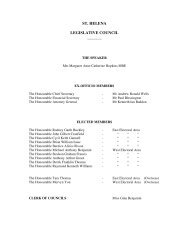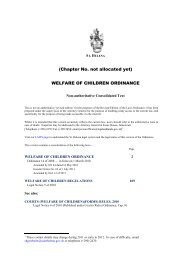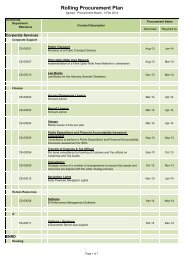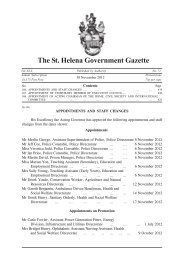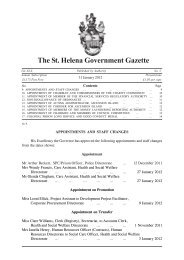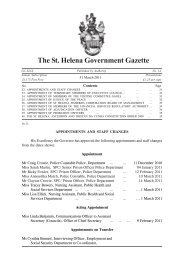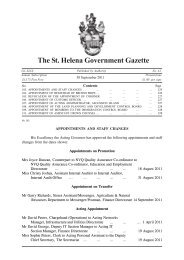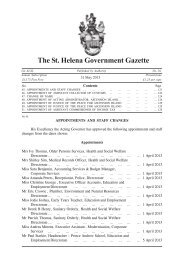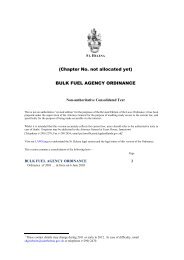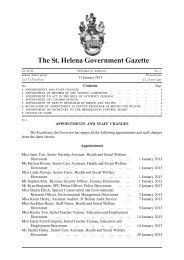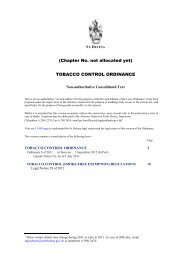Sustainable Economic Development Plan 2012/13 - St Helena
Sustainable Economic Development Plan 2012/13 - St Helena
Sustainable Economic Development Plan 2012/13 - St Helena
You also want an ePaper? Increase the reach of your titles
YUMPU automatically turns print PDFs into web optimized ePapers that Google loves.
<strong>Sustainable</strong> <strong>Economic</strong> <strong>Development</strong> <strong>Plan</strong> P a g e | 6<br />
Section 2: A Tourism Driven Economy: What is Envisaged<br />
The Vision<br />
“To be financially independent and improve<br />
standards of living”<br />
Saint <strong>Helena</strong> will improve community and family life, through increased standards of living, more<br />
employment opportunities and better public services. In order to achieve this Saint <strong>Helena</strong> will grow<br />
its economy, predominantly through the tourism sector.<br />
With the construction of an airport on Saint <strong>Helena</strong> and a proactive approach to developing the<br />
tourism sector, the island could be able to largely finance its own budget by 2021/22 without any<br />
need for overseas aid.<br />
30,000 visitors per year = 600 visitors per week<br />
The current strategy (see Tourism <strong>St</strong>rategy <strong>2012</strong>-16) seeks to attract in the region of 6,300 air<br />
visitors per annum by 2021, with numbers rising thereafter. A detailed study conducted by Atkins to<br />
support the case for constructing an airport on Saint <strong>Helena</strong> expected the tourism number to rise to<br />
30,000 fifteen years after the airport opens.<br />
It is estimated, however, that through the building of the accommodation that is already envisaged,<br />
the island could accommodate 30,000 tourists per annum, 5 which is an average of nearly 600 per<br />
week, much quicker – certainly by 2021/22. Tourism on this scale would provide a daily flight for<br />
both residents and visitors.<br />
This would require development on a scale already predicted - a new cornerstone site like Broad<br />
Bottom or the Devil’s Punchbowl, supported by a boutique hotel (at Ladder Hill Fort for example)<br />
and perhaps 10-12 small (5-20 bedrooms) hotels and guest houses – many of which are already<br />
trading on-island. 6<br />
Table 1: Example of accommodation requirements for 30,000 annual tourists with low occupancy<br />
Number Bed<br />
Potential number of tourists<br />
<strong>St</strong>aff<br />
rooms Nights<br />
supported per year<br />
Large Hotel and Villas 263 596 350 17,484<br />
Medium Hotel 48 86 58 2,535<br />
Boutique 20 36 24 1,056<br />
Boutique 20 36 16 1,056<br />
Small Hotel* 20 36 16 1,056<br />
Small Hotel 20 36 16 1,056<br />
Guest House 10 18 8 528<br />
Guest House 10 18 8 528<br />
Guest House 10 18 8 528<br />
Guest House* 4 7 3 211<br />
Guest House* 7 <strong>13</strong> 3 370<br />
Guest House* 2 4 1 106<br />
Guest House* 5 9 2 264<br />
Guest House* 5 9 2 264<br />
Self Catering* 28 101 56 2,957<br />
Total 472 1,023 570 30,000<br />
Occupancy Rate if<br />
30,000 tourists 56%<br />
* = already exists on-island, except for self catering where 50% exists on-island<br />
5 Providing tourists stay for a week on average.<br />
6 For more detail on potential development areas see the Saint <strong>Helena</strong> Land <strong>Development</strong> Control <strong>Plan</strong> (<strong>2012</strong>)<br />
Saint <strong>Helena</strong> a tourism driven economy: Small Footprint, Huge <strong>St</strong>ep Forward



